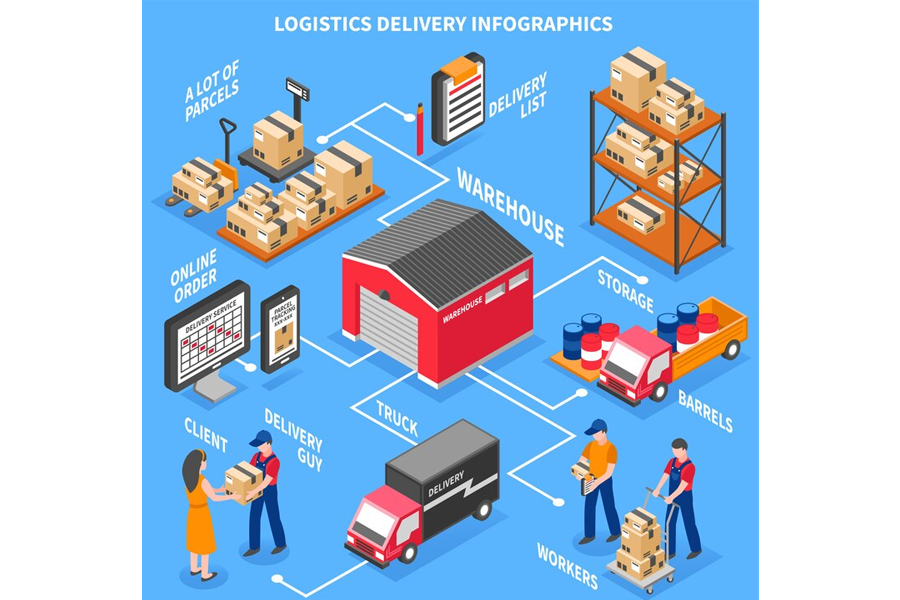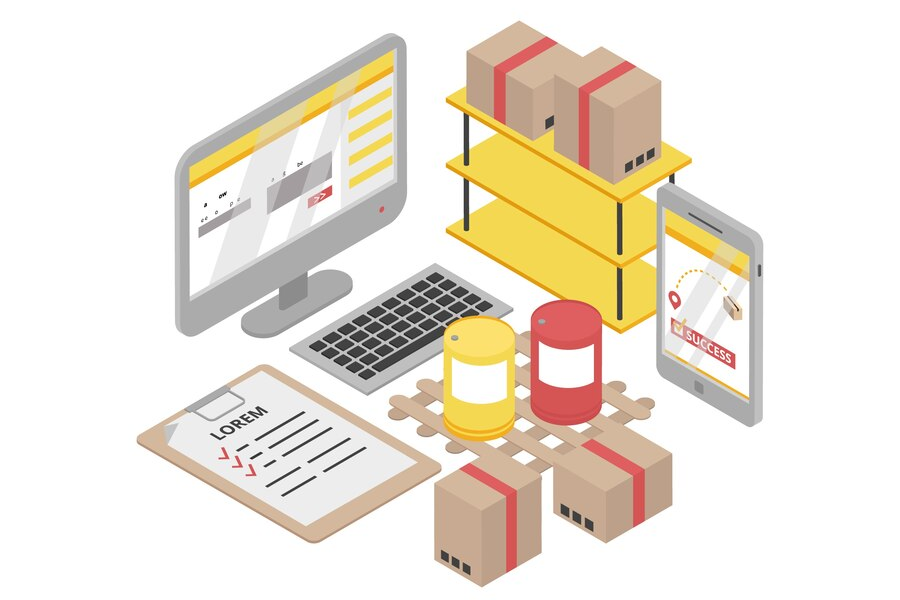
Many gurus will tell you the secrets to business. They’ll tell you things like your mentality, entrepreneurial spirit, or passion. But successful business owners know that it lies in delighting your customers – and that begins by organizing your stock.
Good businesses understand the value of categorizing your stock-keeping units (SKUs).
Having systems in this area makes it easy to track, manage, and analyze inventory – making operations efficient and delighting your customers. That’s what the next few sections are going to tell you.
What is SKU?
You don’t go into a business with only five items in your stock. The very moment you open, you likely have a variety of products, all ready for your customers.
If you’ve run a stall or a small shop, then you know how complex keeping small-scale inventory can be. But this difficulty is compounded by large business.
Imagine you have an Indonesian clothing line that’s grown big, with hundreds of transactions every day. At that point, you probably have a couple hundred of inventory in your warehouse, with more being transported, produced, and designed every single day.
How do you keep track of all these items and product variants? How do you get the customers what they want? That’s what SKUs are for.
An SKU, or stock-keeping unit, is a unique identifier assigned to each product in a business’s inventory. Through these, you can track and manage stock across various functions of your business, from storage to sales, to order fulfillment.
These items can vary. Typically, they’re stickers with an alphanumeric item number in them, giving them their designations. But more recently, you can also see them as barcodes or QR codes.

Why SKUs are Important for E-commerce
Inventory management is an often overlooked aspect of e-commerce, but it’s essential.
Without a proper product classification and identification system, your operations will be slow. More than that, you’ll likely introduce human error into the system, giving your customers the wrong orders or nothing at all.
But don’t worry, SKU standardization is learnable.
With the right information, you can implement the best practices. This section will discuss everything you need to know about its importance, and how you can have that for your business.
Enhancing Data Accuracy
When you’re running a business, there’s nothing more important than having accurate data. On this fact lies everything you’re going to do for your business. Having accurate data ensures that your decisions are reliable – from sales projections, and inventory accuracy, to warehousing calculations.
With accurate data, you can make informed decisions that improve your business. If your data is inaccurate, you’ll make misinformed decisions that can ruin you.
To maintain data accuracy when standardizing SKUs, consider the following best practices:
- Implement consistent formatting: Use a uniform format for all your SKUs to avoid duplicates and confusion. Decide on a structure that includes categories such as product type, size, color, and other relevant SKU attributes.
- Conduct regular audits: Do regular audits of your SKU data to catch issues before they develop into something. Check outdated SKUs, ensure all items are correctly categorized, and improve stock-level management.
- Schedule regular training: Well-trained employees are less likely to make mistakes and data inaccuracies. Instruct them on creating new SKUs, how to log items into and out of inventory, and data integrity practices.
- Automate where possible: Use software to minimize human error in data entry and management. Some tools automatically enter and track data throughout your warehousing procedure. Find what works best and implement it.
Data is one of the most important aspects of running a business. Without the right data, you can’t rely on your decisions, and you might even hurt your customers (for example, if you frequently display sold-out items).
By implementing these practices, you significantly improve SKU data accuracy.
Interoperability and Integration
An SKU makes data about your inventory available on the company’s other platforms. Through this data, you can connect various functions like inventory management, sales, and customer service into one convenient system.
You can easily track inventory levels, process orders faster, and manage data across different platforms without inconsistencies. This enhances the efficiency and accuracy of your data across various operations. When your systems communicate effectively everything moves smoothly.
Here are things to consider to ensure interoperability and integration when standardizing SKUs:
- Use universal standards: Adopt widely recognized standards for SKU formats to ensure compatibility across different systems.
- Centralized database: Maintain a centralized database where all SKU information is stored. This helps different systems access the same, up-to-date data.
- Regular system updates: Keep all your systems updated and ensure they are compatible with each other to facilitate smooth communication.
If your systems are not interoperable and integrated, you’ll have a hard time moving information from one part of your business to the next. For example, inventory info might not reflect properly on sales, and vice versa. You can easily deliver the wrong items to customers, or fail to fulfill orders outright.
Ensuring your systems interact and share data efficiently is key to avoiding these issues.

Efficient Order Fulfillment
Fulfilling your customers’ orders is the culmination of any business, and you should do it as well as you can.
This involves every step from the moment an order is placed to when it’s handed to them at their house in Indonesia. Some stages are picking, packing, shipping, and even handling returns when necessary.
Efficiency directly impacts customer satisfaction in this area. Fast and accurate fulfillment leads to happy customers, repeat business, and positive reviews, which can drive more sales.
Here are best practices for ensuring efficient order fulfillment through SKU standardization:
- Clear SKU identification: Ensure each product has a unique SKU that clearly identifies it. This prevents confusion during the picking process. The effects of clear product identification will immediately trickle down to actual operation speeds.
- Organized inventory: Organize your warehouse by SKU, grouping similar items. This reduces the time spent searching for products during fulfillment.
- Technology integration: Use technology like barcode scanners and inventory management systems that recognize your SKUs to speed up processing and reduce errors.
On the other hand, if your SKUs are not standardized, delays and errors can frustrate customers. Nobody likes a delayed package, much less something that happens because of human mistakes. Errors in order fulfillment even increase returns and reshipment costs.
You might think that they’re relatively minor things, but they’ll compound into a negative customer experience. Eventually, customers will talk, and it will damage your credibility.
Impact on Reporting and Analytics
These areas involve collecting, organizing, and interpreting data to evaluate your business’s performance. Think sales trends, inventory turnover, and customer preferences — all data points that your SKUs contribute to.
Effective reporting and analysis provide insights that guide strategic decision-making for your business.
For example, by understanding which products are selling well or which aren’t, you make informed choices about stock control, marketing strategy, and pricing strategies. This maximizes profitability.
One impactful best practice is implementing a centralized data system.
By using a single system where all SKU-related data converges, you ensure that everyone in your company is working with the same information. This integration allows for real-time data analysis and reporting.
Bad retail analytics might lead you to make poor business decisions, such as overstocking unpopular products or missing out on trends that could drive sales. Inaccurate data can create financial losses.
Maintaining high standards in data management through SKU standardization is key to avoiding these pitfalls.

Scaling E-Commerce Operations
Expanding is the goal for many businesses – who doesn’t want more products, customers, and sales? But to do this properly, you have to expand without sacrificing efficiency or customer satisfaction.
Too many businesses in Indonesia have failed their expansion. As soon as they grew, their products lowered in quality and customer service suddenly became a nightmare.
But if you properly upgrade your infrastructure, processes, and systems to support your growth, then you can maintain – or even improve – your quality.
SKU standardization is crucial here.
One best practice for this is to design your data architecture to scale with your business. This ensures that your SKU data remains manageable despite the many changes it will face.
If you don’t standardize your SKUs, scaling becomes complicated. Increased inventory can lead to discrepancies, mislabeled products, and difficulties in integrating new items into your unstandardized system.
These issues will make your internal operations grind to a halt. Ultimately, the effects will be felt by customers, and hinder your growth.
Therefore, having a standardized SKU system is essential for scaling efficiently and ensuring your business can thrive as it grows.
Challenges and Considerations
Standardizing your SKU is important, but it’s not always easy. Especially if you’ve already grown, and have just started to optimize down the line – this can present complications that might not have easy solutions.
Before you get to that point, you must understand the common challenges associated with standardizing SKUs. Recognizing them helps to prevent costly mistakes and disruptions in business operations.
Here are the main challenges and considerations when standardizing SKUs:
- Complexity of product range: If you already have a wide variety of products, creating a uniform SKU system that accurately reflects all product attributes can be challenging. You’ll need to dedicate significant time, effort, and resources. That’s why it’s important to think about standardization from the beginning.
- Integration with existing systems: Ensuring that new SKU standards work seamlessly with your current inventory and point of sale (POS) systems requires significant adjustments. Don’t hesitate to tap into available technical support for as long as you need.
- Training and adoption: Employees need to be trained on the new SKU system. Ensuring everyone understands and adopts it consistently can be difficult, especially in larger teams with more things to handle.
- Data migration: Transferring existing product data into a new standardized SKU system can be time-consuming and error-prone. Proper planning is key – don’t let the hassles of data migration impact your operations, especially not on the customer side.
By carefully planning and addressing these considerations, you can ensure that your SKU standardization process leads to a more organized and efficient operation. You’ll be more efficient, scalable, and accurate (data-wise) in the long run.
Tools and Technologies
Standardizing SKUs has a lot to do with the tools and technologies you have. Your retail operations, from warehousing to fulfillment, rely on an ecosystem of hardware and software.
Without the proper tools, you can’t standardize your system enough to make a difference. Not only that, but your performance is also going to suffer, as you’ll be more prone to errors and inefficiencies.
Here are the main tools and technologies of your inventory system:
- Inventory management software: Systems that help track stock levels, orders, sales, and deliveries in real time.
- Barcode scanning systems: Tools that automate the checking-in and checking-out process of inventory, reducing manual entry errors. A barcode system is a good example of this, and there are many variations to choose from.
- Database management systems: Technologies that support the storage, retrieval, and management of SKU data across various platforms.
- Integration platforms: Services that ensure your SKU systems work seamlessly with other business systems like customer relations manager (CRM) and enterprise resource planning (ERP.)
- Data analytics tools: Software that allows you to analyze SKU data to make informed decisions regarding inventory control, sales strategies, and customer preferences.
By investing in the right wares, your SKU standardization will open the doors to improved operational efficiency, enhanced accuracy, and better scalability. All these will fuel your business growth.

Best Practices in Implementing Stock Keeping Units
Now that you know how important standardizing your SKU is, you should learn best practices for guidance. When doing any large-scale improvements like this, consider not just accomplishing the task in the near future, but setting yourself up for success in the long term.
Streamline your process and avoid the most common pitfalls that most businesses go through with these practices.
Here are the best practices for standardizing SKUs:
- Develop a logical and intuitive SKU naming convention. Create a system that incorporates key product attributes logically, such as category, type, size, color, and more. Arrange in a unified SKU hierarchy. This quickly identifies products and reduces the chances of error in handling them.
- Use non-significant digits. Avoid using meaningful information in the digits themselves, such as price or location, which can change over time. Stick to stable, intrinsic attributes to maintain SKU relevance and longevity.
- Limit SKU length. Keep your SKUs between 8-12 characters long to balance the need for detail with the ease of use. Too long SKUs can be cumbersome to manage and prone to input errors.
- Standardize across channels. Multi-channel retail presents unique challenges when it comes to SKU standardization. Ensure your SKU system is consistent across all sales channels and storage locations. This consistency is vital for accurate reporting and product tracking.
- Implement barcode integration. Align your SKU system with barcode technology to automate merchandise tracking and reduce manual entry errors. Barcodes help in maintaining accurate inventory levels and speeding up the checkout process.
- Regularly review and update. Set a schedule to review your SKU system and make adjustments as needed. This can involve phasing out obsolete SKUs, updating categories, and incorporating new product lines
By adopting these best practices, you ensure your inventory system isn’t just standardized. It’s easy to use, highly scalable, and capable of supporting whatever goals your business might have.

Final Thoughts
You might not think of a stock-keeping unit system as important – after all, there are far more “exciting” aspects of a business that you can focus on.
But if you’re neglecting your inventory practices, your business will eventually suffer. Your business operations will experience a lot of internal friction, wearing on your systems and employees. Eventually, your customers will feel it through missed orders, wrong items, and overly long shipping times.
Don’t let that happen to your business. Instead, standardize your inventory management systems and follow the best practices outlined in this article.
Frequently Asked Questions
What is an SKU and why is it important for my business?
An SKU, or Stock Keeping Unit, is a unique identifier for everything you have in your inventory. A good product classification code helps you track your products accurately. SKU optimization is also helpful for better demand forecasting, shelf management, and even supply chain management.
How does SKU standardization impact vendor management?
Good standardization streamlines your procurement and supply chain processes by setting clear reorder points and safety stock levels. This lets you communicate with vendors effectively, making it easier to manage inventory and meet demand.
What are the common mistakes to avoid when standardizing SKUs?
Most businesses overcomplicate their SKU system, using significant digits that might change (like price or supplier codes). Other common problems also include inconsistency across different channels or departments. Keep it simple, focused, and consistent.